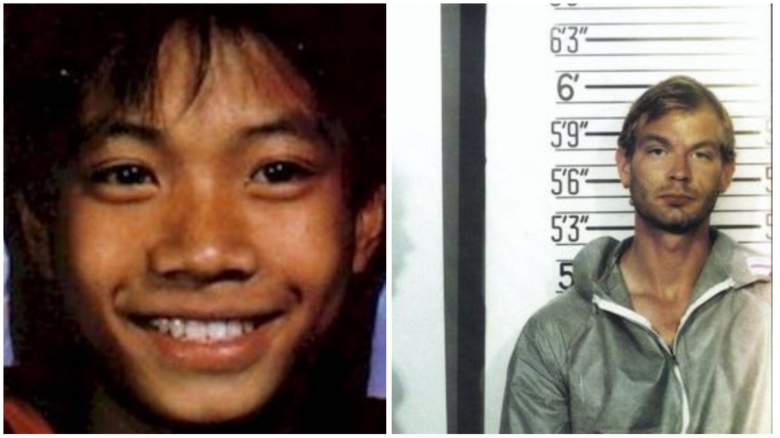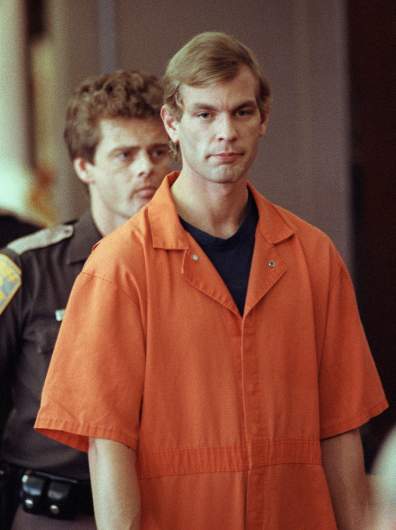
Konerak Sinthasomphone was a 14-year-old Milwaukee boy who was given back to serial killer Jeffrey Dahmer by two Milwaukee police officers.
Over the objections of neighbor Glenda Cleveland, the officers, John Balcerzak and Joseph Gabrish, believed Dahmer’s lies that Konerak was his boyfriend, and they allowed the serial killer to take the naked, bleeding boy, who had wandered into the street, back to his apartment.
Dahmer promptly killed the teen.
Dahmer was previously convicted of sexually assaulting Konerak’s younger brother. That crime landed him on state supervision while he was committing multiple murders.
Here’s what you need to know:
1. Two Milwaukee Police Officers Turned Konerak, Bleeding & Naked, Over to Dahmer
Joseph Gabrish and John Balcerzak were the two Milwaukee police officers who handed a naked, bleeding 14-year-old boy over to serial killer and cannibal Jeffrey Dahmer.
They did so over the objection of Dahmer’s neighbor Glenda Cleveland, and other women at the scene. The boy, Konerak Sinthasomphone, was murdered by Dahmer shortly thereafter. Sinthasomphone was an Asian boy who was from a family of Laotian immigrants who had fled Communism.
The Netflix series shows this scene, and it’s a true story.
Gabrish and Balcerzak became known as the “Dahmer cops.”
What happened to Gabrish and Balcerzak? Despite the controversy, which generated major headlines at the time of Dahmer’s arrest, both men went on to enjoy lengthy careers in Wisconsin law enforcement.
Dahmer’s killings are getting renewed attention as a result of a new Netflix series. “Monster: The Jeffrey Dahmer Story” started streaming on September 21, 2022. “Across more than a decade, 17 teen boys and young men were murdered by convicted killer Jeffrey Dahmer. How did he evade arrest for so long?” the Netflix site for the show asks.
According to OnMilwaukee.com, two months before Dahmer’s 1991 arrest, the two officers “responded to a call in an alley next to Dahmer’s apartment.” The report came in as a “man down” and “badly beaten.” It was Sinthasomphone, 14.
The officers “arrived at the scene to see what appeared to be a young man, naked and dazed wrapped in a blanket with Milwaukee Fire Department paramedics. Jeffrey Dahmer was standing at his side,” OnMilwaukee.com reported.
According to OnMilwaukee.com, Dahmer had met Konerak at a mall and asked to take pictures of him; he drugged him, but Konerak escaped when Dahmer went to buy liquor. Dahmer convinced Gabrish and Balcerzak that it was a “domestic situation,” and they gave Konerak back to the serial killer, who killed him, according to OnMilwaukee.
According to WTMJ-TV, the officers ignored Cleveland’s vigorous objections.
The boy was “naked and bleeding,” the television station reported, but Dahmer “told the officers the boy was an adult and his lover and he was drunk.”
An Associated Press story from November 1992, accessed through Newspapers.com, quoted Cleveland.
Cleveland told the AP that she was “so worried about the naked, dazed youth” that she considered protesting the police department.
“I thought about a couple of stupid things, like handcuffing myself or sitting on the steps and not moving,” Cleveland told AP.
Cleveland, her niece Nicole Childress, neighbor Tina Spivey and Cleveland’s daughter Sandra Smith told police “they felt Sinthasomphone was trying to get away from Dahmer,” the AP reported.
2. The Milwaukee Police Chief Fired Gabrish & Balcerzak, But a Court Reinstated the Officers
According to the Advocate, after the incident was revealed, the two officers were fired by the police chief, Philip Arreola, but a court order reinstated them. Reserve Judge Robert Parins made the ruling.
A 1994 Associated Press article reported that Parins ruled that “the firings were too severe a punishment and that former Officers John Balcerzak and Joseph Gabrish should be reinstated, with back pay of about $55,000 each.”
The Fire and Police Commission appealed to no avail. The chief had fired the officers for “failing to follow police procedures,” AP reported.
The Washington Post reported that Arreola fired the cops for “acts of omission” that included “a failure to take witnesses’ names at the scene and failure to take the 14-year-old boy into protective custody.”
3. Dahmer Was Previously Convicted of Molesting Konerak’s Brother

GettyJeffrey Dahmer.
According to a 1991 article in the Appleton Post-Crescent newspaper by the Associated Press, Konerak’s family had fled Laos a decade before.
Their 13-year-old son, Konerak’s brother, was sexually assaulted by Dahmer
The sexual assault came two years before Dahmer murdered Konerak and Dahmer apologized for it, the article says.
“The family is filled with a lot of different emotion. Anger is certainly one of them. They hope and pray no one else will ever have to endure such a tragedy again,” Rev. Peter Burns told the newspaper.
Konerak’s mutilated remains were discovered in Dahmer’s apartment.
In the earlier assault, Dahmer was convicted of second-degree sexual assault for “fondling Sinthasomphone’s brother” then 13. He offered the boy $50 to pose for nude photos. According to the AP, Dahmer spent only 10 months in jail and received five years probation. A judge granted “his early release in May 1990” after Dahmer promised not to commit more crimes.
The article says people in the Laotian community “believe Dahmer stalked Konerak in retaliation for the prioer sexual assault conviction.” That was not proven.
4. Sinthasomphone Was Last Seen Leaving to Play Soccer
According to a 1991 article in the La Crosse Tribune, Konerak disappeared in May 1991 when he “left for a downtown park to play soccer.”
“The whole thing is crazy. It is terrible,” Anoukone Sinthasomphone, Konerak’s older brother, said.
Nicole Childress, 18, told the AP that Dahmer wrestled Konerak away from her after she called police. He was naked, “appeared to be drinking and was bleeding from his buttocks.”
“We tried to give the policemen our names, but he just told us to butt out,” said Sandra Smith, 18, who was also there.
5. Balcerzak & Gabrish Went on To Have Lengthy Law Enforcement Careers
Balcerzak went on to head the Milwaukee Police Association, the union of rank-and-file police officers. He retired from the force in 2017, the WTMJ-TV television station reported.
His tenure as MPA president was not without controversy.
In 2009, Milwaukee Magazine wrote, “Longtime Milwaukee Police Union President Bradley DeBraska could be criticized for many things, but he was a very smart, proactive leader. His successor, John Balcerzak, is a turning out to be a disaster. Odds are the union membership will replace him — and soon.”
According to UPI, Balcerzak testified at Dahmer’s trial. “Mr. Dahmer remained calm and forthright through the entire investigation,” Balcerzak said. “He was clean shaven, clean dressed and his clothes were not in disarray.”
Over the years, Balcerzak also owned a tavern, according to the AP.

Grafton PDJoseph Gabrish
Gabrish left the Milwaukee force. He was named an interim police chief in the Grafton Police Department, where he served as a captain, according to the Ozaukee Press.
“I’m looking forward to working with the Village Board and the people here to make this a safe community,” Gabrish said in 2019, that newspaper reported.
“Gabrish joined the department as an officer in 1993 and became second in command in 2007. Prior to joining the department, Gabrish was an officer with the Milwaukee Police Department for nearly 11 years,” the Ozaukee Press reported, adding, “Gabrish is also the chief of police in the Town of Trenton, where he lives. He started the Trenton Police Department in 1997.”
The newspaper reported that Gabrish went on to get a master’s degree.
Gabrish is now retired. According to UPI, Gabrish testified that Dahmer was “polite and gave us no reason to suspect anything of him at all. He was very cooperative with us.” He did detect an odor in Dahmer’s apartment though.
“I equated (it) to that of a bowel movement or somebody had just gone to the bathroom,” Gabrish testified.
READ NEXT: Jeffrey Dahmer’s Cause of Death.

